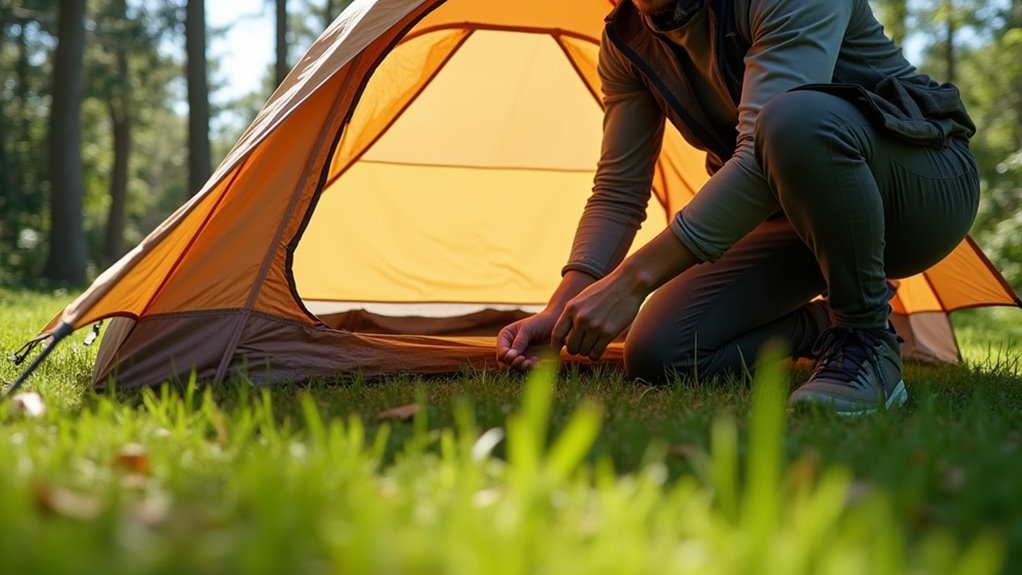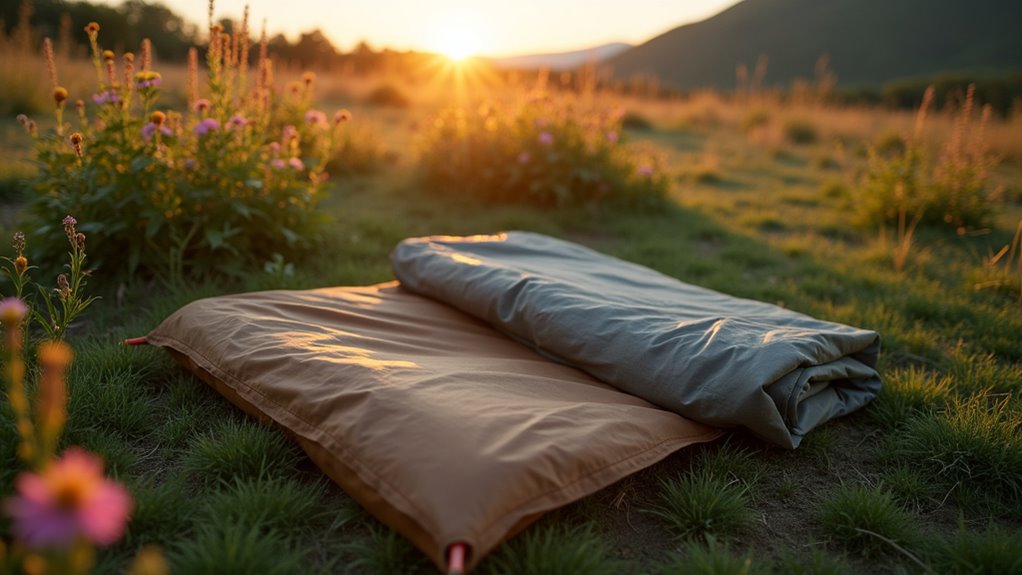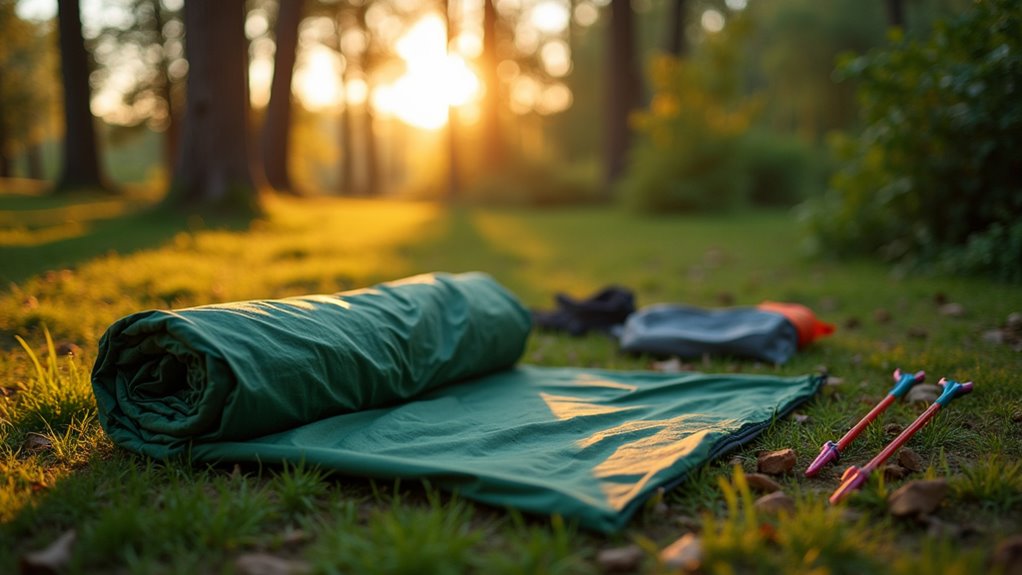How To Close Tent
This post contains affiliate links. As an Amazon Associate, we earn from qualifying purchases.
To close your tent properly, begin by loosening its structure—remove stakes and guylines to let it relax. Then, unclip the rain fly, open the doors to release trapped air, and fold the tent flat. Afterward, fold each side toward the center and roll the tent tightly while pressing out air. For pop-up tents, follow your specific manual to collapse them safely. Finally, store all components in a cool, dry place to preserve their condition. Further details and step-by-step instructions will be provided below for those who want to ensure the best care for their tent.
Essential Facts in 30 Seconds
- Remove tent stakes and guylines to reduce frame tension before closing.
- Unclip rain fly and open doors to release air.
- Lay tent flat, close zippers, and fold sides toward the center.
- Roll tent tightly, press out air, and secure with straps.
- Store rolled tent in a cool, dry place with all components together.
Loosening the Tent Structure

Loosen the tent structure first to avoid damage during take-down. Remove all tent stakes and guylines carefully. This step reduces tension in the tent frame. Remember to check the weather for wind conditions, as this may affect how you take down the tent.
Windy conditions may require leaving corner stakes in place for stability. Unclip the rain fly from poles and guylines, letting it hang loosely. This prevents stress on the tent frame.
Open tent doors and vents to let air escape and lower internal pressure. Unlock pole locks to reduce tension before folding. Additionally, ensure you remove any stakes carefully to prevent damage during the collapse.
Taking these steps protects your tent and helps it last longer. Proper care ensures your gear stays strong for many trips.
Folding and Collapsing Techniques
Loosen the tent structure first. Folding and collapsing the tent properly keeps it in good shape. Follow these simple steps:
Lay the tent flat on a clean surface. Close all zippers and windows to keep its shape and release tension in the fabric to make folding easier.
Fold one side toward the center. Then fold the opposite side the same way. This makes a compact rectangle.
Fold the edges into the middle. Keep folding until the tent is one-quarter of its original width.
Roll the tent tightly from one end to the other. Press out all the air while rolling.
Use straps to keep the tent from unrolling during transport. For tents with poles, align and fold them next to the tent. Make sure to release tension in the tent before beginning the folding process.
Place the poles inside before rolling. This method saves space and makes setup easier next time.
Packing the Flysheet and Main Tent

Packing the flysheet and main tent correctly keeps them strong and easy to set up. First, lay both flat on a clean, dry surface. Brush off dirt to keep the flysheet clean. Clean flysheets last longer and protect your tent better. Check that everything is dry to stop mildew from growing, as storing a tent damp can lead to serious damage. Ensure area around the tent is clear of debris or sharp objects before packing.
Fold the flysheet lengthwise into thirds or halves. Make a neat rectangle. Close all zippers on the main tent. Fold its edges toward the center to form a long rectangle. Roll the flysheet and tent tightly. Put poles inside the roll to save space. Use straps or ties to hold the roll together.
Put the rolled flysheet and tent into the tent bag. Start by placing the stakes bag at the bottom. Store the bag in a dry place. Avoid squashing the tent during long storage to keep it safe and ready for your next trip.
Additional Tips for Pop-Up Tents
Closing a pop-up tent is easier with a partner. Talk clearly to avoid mistakes. Follow these tips for a smooth pack-up:
- Read the manual carefully. Each tent has its own closing steps, which may include specific instructions for storing the tent after use.
- Release leg locks and corner buttons together. Keep the frame steady to prevent any accidental injuries during the process.
- Don’t force poles or fabric. Keep the tent clean and dry to avoid damage. Also, practice finding the best angle for collapsing to ensure efficient packing.
Rolling and Storing Tent Components

Close your pop-up tent carefully. Fold the rain fly and tent body lengthwise. Smooth the fabric edges to push out trapped air. Keep the inner tent door zipper partly open. This lets air escape. Regularly cleaning your tent helps prevent mildew and odors from forming.
Roll the rain fly from the top toward the open end. Add poles and stakes inside the roll to keep it tight. This stops air pockets and protects the tent.
Store your rolled tent in a cool, dry place. Avoid squeezing it tightly in stuff sacks. Use breathable bags or hang the tent if you can. Regularly check stored tent for any signs of moisture damage to help maintain its longevity.
Check your stored tent often for wet spots or bugs. Keep all tent parts together to make setup faster next time. These steps help your tent last longer and stay ready for your trips.
Frequently Asked Questions
How Do I Clean My Tent Before Packing It?
Before packing your tent, clear out all dirt and leaves by shaking it well. Use a soft cloth and clean water to spot clean any dirty areas. Treat tough stains gently with mild soap and water. Make sure the tent is completely dry to stop mold from growing. Store the tent in a cool, dry place. This care helps the tent last for many trips. Remember, a clean and dry tent keeps you safe and comfortable outdoors.
Can I Leave the Tent Wet While Storing?
Storing a wet tent causes mold and mildew to grow quickly. Mold damages fabric and makes the tent smell bad. Always dry your tent completely before packing it away. Find a shady, airy spot to dry it after use. Store the tent in a cool, dry place. Use a loose bag or a breathable container, not a tight plastic one. This keeps the tent fresh and lasts longer. Taking these steps saves money and keeps your tent ready for the next trip.
What Should I Do if Tent Fabric Is Damaged?
Damaged tent fabric needs quick fixing to stay strong. Clean the torn area well. Cut off any loose threads or rough edges. Pick a patch that fits the tear size. Use glue or tape made for tents to stick the patch on. Press hard so it holds tight. This keeps water out and stops the tear from growing. Check the patch after each trip to be sure it still sticks well. A good repair can make your tent last many more camping trips.
How Do I Prevent Mildew During Storage?
Prevent mildew by drying your tent fully after every use. Sarah dries her tent well after camping in rain. Store your tent in a cool, dry place with good airflow. Avoid damp or dark spots to stop mold growth. Mildew grows fast in wet, warm areas. Keep your tent clean and dry to protect it. Use a breathable bag, not plastic, to allow air circulation. Check your tent regularly for any damp spots or smell. This simple care keeps your tent fresh and mildew-free.
What’s the Best Way to Transport My Tent?
Use strong carry bags and compression sacks to move your tent. Pack poles, stakes, and rainfly with care. Keep bulky items tight to save space. Arrange everything so it fits well in your car. This makes loading and unloading easier and faster. Protect your gear from dirt and moisture by sealing bags properly. Simple steps like these keep your tent safe and ready to use.
Conclusion
Packing your tent feels easy when you think of it like folding a sleeping bag. First, loosen the tent poles and flatten the tent on the ground. Fold the tent carefully to avoid wrinkles and damage. Rolling the tent instead of folding helps keep it neat and dry. A well-packed tent saves space and stays ready for your next trip. Taking time to close your tent properly protects it and makes setup faster later. Remember, good care means your tent lasts many camping trips.
